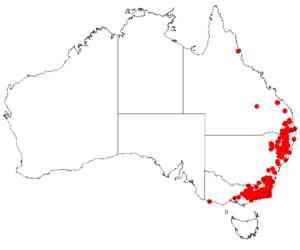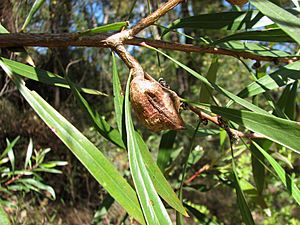Tree hakea facts for kids
Quick facts for kids Tree hakea |
|
|---|---|
 |
|
| Near Cathcart | |
| Scientific classification | |
| Genus: |
Hakea
|
| Species: |
eriantha
|
 |
|
| Occurrence data from AVH | |
The Tree Hakea (Hakea eriantha) is a special type of shrub or small tree. It grows only along the east coast of Australia. This plant has pretty white flowers that look a bit woolly. Its leaves are long and narrow, and new leaves often have a reddish color. You can find Tree Hakea growing in higher places, often in damp forests or woodlands with Eucalyptus trees.
Contents
What Does Tree Hakea Look Like?
The Tree Hakea is a thick shrub or a small tree. It can grow from 1 to 5 meters (about 3 to 16 feet) tall. Its leaves are long and thin, or sometimes shaped like an egg. They are usually 8 to 18.5 centimeters (about 3 to 7 inches) long. Young leaves can be smooth or have tiny, flat hairs. They end with a short, sharp point.
Flowers and Fruit
Tree Hakea flowers are creamy white. They grow in groups of 6 to 10 flowers on a small stalk. These flowers appear where the leaves join the stem. Each flower has a fuzzy stalk covered in soft white hairs. The flowers bloom between August and November.
After the flowers, the plant grows woody fruits. These fruits are smooth and have brown, blister-like bumps. They are about 1.9 to 3.2 centimeters (about 0.7 to 1.2 inches) long. Each fruit ends with a short, sharp point and has a small beak.
How Tree Hakea Got Its Name
The Tree Hakea was first officially described in 1830. A botanist named Robert Brown gave it its scientific name, Hakea eriantha. He studied a plant sample found near the Hastings River by Charles Fraser.
The name eriantha comes from two old Greek words. Erion means "wool," and anthos means "flower." This name refers to the soft, hairy flowers of this plant.
Where Tree Hakea Grows
You can find the Tree Hakea in Eucalyptus woodlands or forests. It also grows at the edge of rainforests. Its range stretches from Gladstone in Queensland, all the way south to Gippsland in Victoria.
Why Tree Hakea is Important
The Tree Hakea grows quickly. It is a good plant for gardens in wet and cold places. People use it for hedges or to create a screen.
This plant is also a food source for some native Australian birds. The gang-gang cockatoo (Calocephalon fimbriatum) and the yellow-tailed black cockatoo (Calyptorhynchus funereus) both like to eat from the Tree Hakea. They often live in the same areas as the plant.


